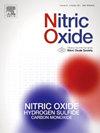硫化氢介导SIRT3巯基化:一种预防铁下垂和心房纤维化的新方法。
IF 3.2
2区 生物学
Q2 BIOCHEMISTRY & MOLECULAR BIOLOGY
引用次数: 0
摘要
背景:硫化氢(H2S)已被证明可以对抗铁下垂和心房纤维化,但其潜在的机制仍不完全清楚。本研究旨在探讨H2S如何调节铁下垂减轻心房纤维化。方法:采用血管紧张素II (Angiotensin II, Ang-II)调节SIRT3、β-catenin和铁吊标志物的表达,建立体内和体外心房纤维化模型。Western blotting分析铁下垂和纤维化相关蛋白的变化。组织学评估,包括苏木精和伊红(HE), Masson染色评估心房纤维化。采用心脏超声评估左心房功能。体外用活性氧(ROS)水平和铁染色监测铁下垂和氧化应激。结果:在房颤患者心房组织中,观察到铁下垂标志物和心房纤维化显著增加。在心房纤维化的动物和细胞模型中,巯基化SIRT3的减少和β-catenin表达的升高与铁下垂和纤维化标志物的增加有关。NaHS (H2S供体)治疗逆转了这些变化,减少了铁下垂和纤维化。重要的是,抑制巯基化SIRT3进一步上调β-catenin,加剧铁下垂和纤维化。阻断β-catenin可有效减轻ang - ii诱导的心房纤维化模型中的铁下垂和纤维化。结论:H2S通过上调SIRT3巯基化,拮抗Wnt/β-catenin信号通路,减轻心房纤维化,抑制铁下垂。这些发现表明,靶向H2S-SIRT3-β-catenin信号轴可能为心房纤维化和相关心律失常提供了一种有希望的治疗策略。本文章由计算机程序翻译,如有差异,请以英文原文为准。
SIRT3 sulfhydrylation by hydrogen sulphide: A novel approach to prevent ferroptosis and atrial fibrosis
Background
Hydrogen sulfide (H2S) has been shown to counteract ferroptosis and atrial fibrosis, yet the underlying mechanisms remain incompletely understood. This study aims to investigate how H2S regulates ferroptosis to alleviate atrial fibrosis.
Methods
In vivo and in vitro models of atrial fibrosis were established using Angiotensin II (Ang-II) to modulate the expression of SIRT3, β-catenin, and ferroptosis markers. Western blotting was employed to analyze changes in proteins related to ferroptosis and fibrosis. Histological evaluations, including Hematoxylin and Eosin (HE), and Masson's staining were performed to assess atrial fibrosis. Cardiac ultrasound was used to assess left atrial function in vivo. In vitro, reactive oxygen species (ROS) levels and iron staining were used to monitor ferroptosis and oxidative stress.
Results
In atrial tissue from patients with AF, significant increases in ferroptosis markers and atrial fibrosis were observed. In both animal and cell models of atrial fibrosis, reduced sulfhydrylated SIRT3 and elevated β-catenin expression were associated with increased ferroptosis and fibrosis markers. Treatment with NaHS, a donor of H2S, reversed these changes, reducing both ferroptosis and fibrosis. Importantly, inhibition of sulfhydrylated SIRT3 further upregulated β-catenin, exacerbating ferroptosis and fibrosis. However, blocking β-catenin effectively alleviated Ang–II–induced ferroptosis and fibrosis in the atrial fibrosis model.
Conclusion
H2S alleviates atrial fibrosis and inhibits ferroptosis by upregulating SIRT3 sulfhydrylation and antagonizing the Wnt/β-catenin signaling pathway. These findings suggest that targeting the H2S-SIRT3-β-catenin signaling axis may offer a promising therapeutic strategy for atrial fibrosis and associated arrhythmias.
求助全文
通过发布文献求助,成功后即可免费获取论文全文。
去求助
来源期刊

Nitric oxide : biology and chemistry
生物-生化与分子生物学
CiteScore
7.50
自引率
7.70%
发文量
74
审稿时长
52 days
期刊介绍:
Nitric Oxide includes original research, methodology papers and reviews relating to nitric oxide and other gasotransmitters such as hydrogen sulfide and carbon monoxide. Special emphasis is placed on the biological chemistry, physiology, pharmacology, enzymology and pathological significance of these molecules in human health and disease. The journal also accepts manuscripts relating to plant and microbial studies involving these molecules.
 求助内容:
求助内容: 应助结果提醒方式:
应助结果提醒方式:


